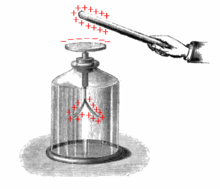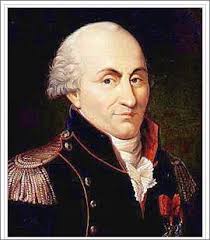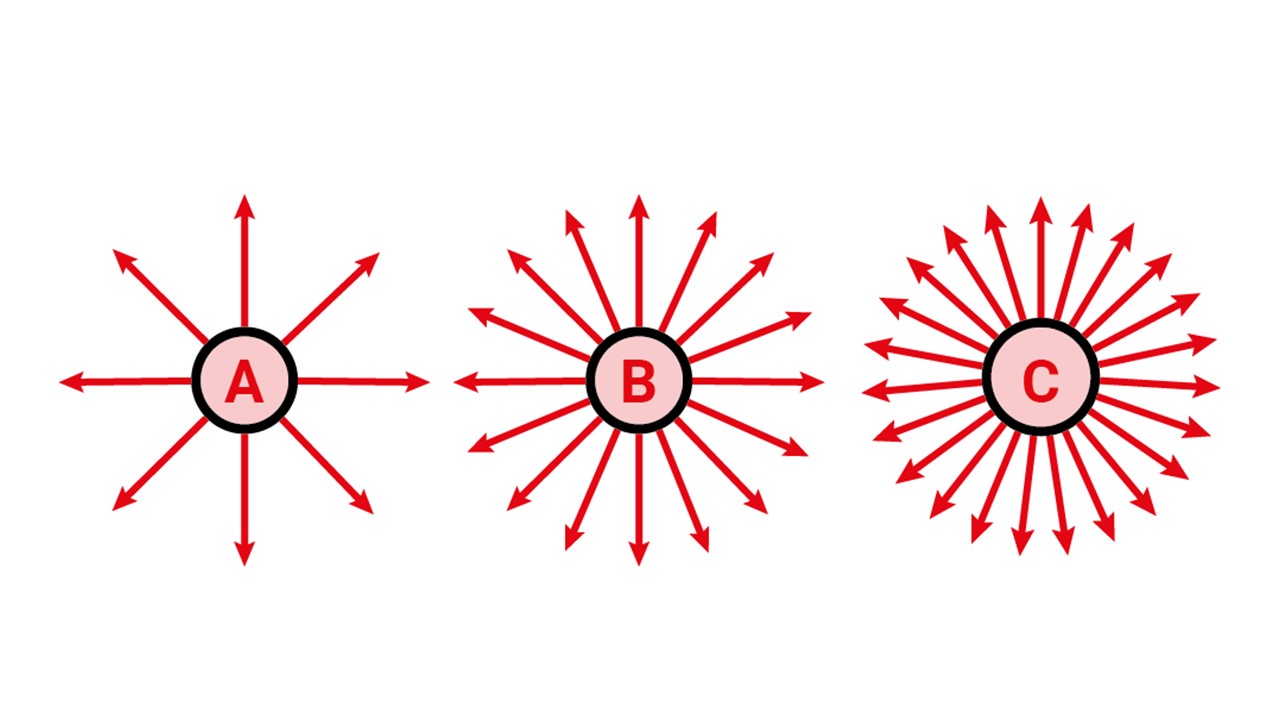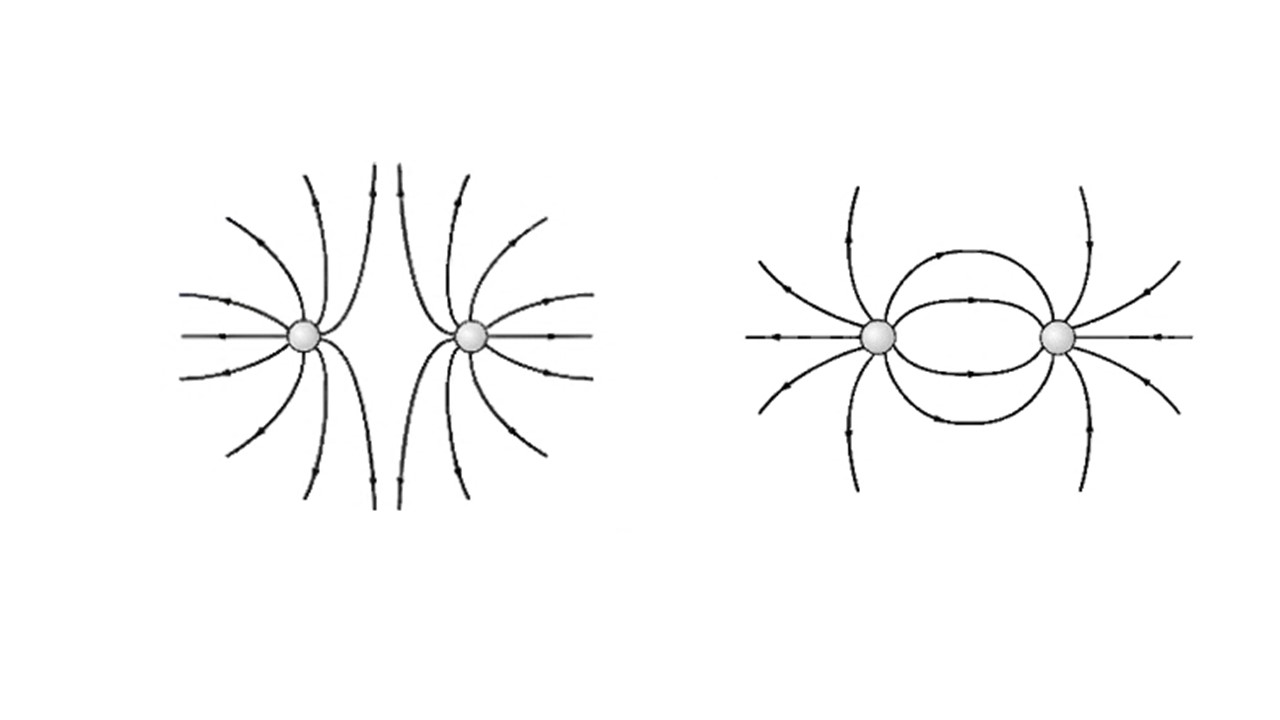Forces and Fields


Basic Concepts:
Elements are made up of atoms. Atoms consist of protons, neutrons and electrons. Protons have a charge of +1.60x10-19 C. This is called the elementary charge.
Electrons have a charge of -1.60x10-19. The SI unit for charge is the Coulomb, symbolized as C. Atoms have the same number of electrons and protons so the net charge is 0.
When an atom gains or loses electrons, it becomes an ion. The protons cannot move but electrons can.
Some materials hold onto electrons more tightly than others. When two different substances are rubbed against each other, electrons can be transferred from one substance to the other. One material gains electrons and becomes negatively charged, while the other material loses electrons and becomes positively charged. The total amount of charge in the system remains the same, i.e., is conserved.

An electroscope is an equipment used to detect the presence of electric charge. Because like charges repel and opposite charges attract, the further apart the leaves are, the greater the charge.
is a redistribution of charges in an object caused by the electric field of a nearby charge. For example, if a positively charged object is brought near an uncharged metal object, the mobile negatively charged electrons in the metal will be attracted by the external charge, and move to the side of the metal facing it, creating a negative charge on the surface. When the electrons move out of an area, they leave a positive charge due to the metal atoms' nuclei, so the side of the metal object facing away from the charge acquires a positive charge. These induced charges disappear when the external charge is removed.
If you place a positively charged rod near an electroscope, electrons in the leaves move towards the head leaving the leaves less positive. When the rod is removed the leaves return to their original position. This also happens when a negatively charged rod is placed near the head, but this time round, the electrons move to leaves and cause repulsion between the leaves.
When a charged object touches another, the charges are shared equally between the objects. When a previously neutral object is charged by contact, it develops the same charge as the charged object.
When an electroscope is touched by a charged rod, the leaves remain separated, the electroscope is permanently charged. If a positively charged object touches a neutral object, some of the free electrons from the neutral object will
move to the positively charged object.
If a negatively charged rod is brought close to a conductor that is connected by a wire to a much larger object, electrons from the conductor will move along the wire to the larger object in order to become evenly distributed. When the wire connecting the electroscope and the object is broken the electroscope is left with a positive charge.

Charles Coulomb (1736 - 1806) used torsion balance to quantify the amount of force between two stationary, electrically charged particles. The law was first discovered in 1785 by French physicist Charles-Augustin de Coulomb, hence the name. The law states that the magnitude of the electrostatic force of attraction or repulsion between two point charges is directly proportional to the product of the magnitudes of charges and inversely proportional to the square of the distance between them.
Where k is the Coulomb's law constant, which is 8.99 x 109 N.m2/C2, q1 and q2 are the signed magnitudes of the charges, and r is the distance between the charges.

This concept was developed by Michael Faraday, who described the idea of lines of force. An electric field is a sphere of influence, in which a force can affect an object (repel or attract) at a distance without contact. In addition to electric fields, spheres of influence are also used in magnetic and gravitational forces. An electric field is a vector whose direction is defined as the direction of the electric force acting on a positive 'test charge'.

The density of electric field lines around an object reveals the quantity of charge. In this example shown here, the charge on C is greater than the charge on A and B, the charge on B is lower than C, but greater than A. The electric field density also indicates that the charge closer to the object is higher than the charge as you move further away from the object.

The net electric force determines the shape of the field lines. The net electric field is the vector sum of each charge's electric field. The net force is tangential to the curved field lines. Note that field lines cannot intersect and they always start from the positive charge and end at the negative charges. Like charges show repulsion (left image) and opposite charges attract (right image). The shape of the conductor can affect the electric field strength with stronger fields near sharp corners. The electric field inside a hollow conductor is 0.
Electric flux is a measure of the number of field lines passing through a surface. The surface orientation affects the amount of electric flux through it.
The potential difference is the work required to move a charge between two points in an electric field, divided by the charge. It can also be described as the amount of potential energy stored in a system per Coulomb of charge.
Where V is the potential difference, ΔE is the change in energy and q is the charge of the object in electric field.
An electron volt (eV) is the quantity of energy that a single electron gains when it is accelerated through a potential difference of 1 volt.
Parallel plates that have opposite charge will produce a uniform straight electric field. The strength of the electric field will depend on the distance between the two plates and the voltage of the battery.
Where d is the distance between the two plates.

Cathode ray tubes are electric fields to accelerate electrons and other electric fields (deflection plates) are used to move the electrons along the front of the tube. The cathode is connected to a large negative potential and the anode is connected to a positive potential.
The cathode is heated and the electrons are activated and accelerated to a high speed by the electric field between the cathode and anode. Electrons then pass through the hole in the anode and then move at uniform velocity until they reach the deflection plates, which steer the electrons across the front of the tube. CRTs are used for TV screens and computer monitors.